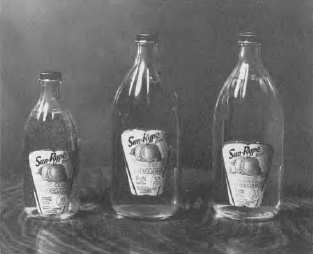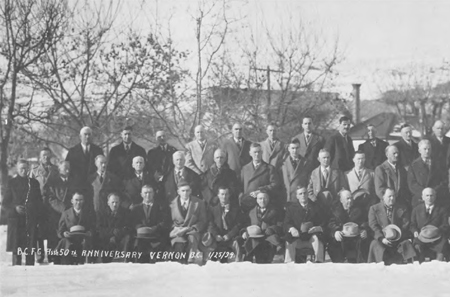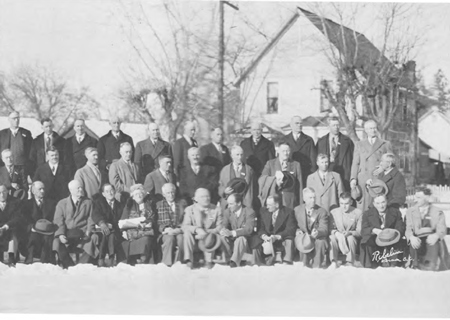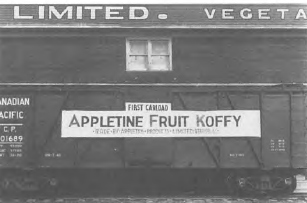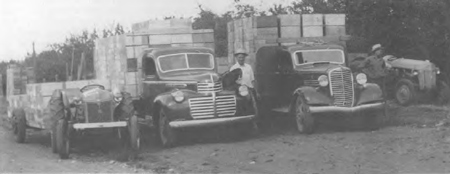News & Events More |
Central Selling: From Resolution to RealityThe Golden Jubilee 50th Annual Convention of the B.C.F.G.A. in January, 1939, passed an emphatic declaration in favour of central selling. It remained for the committee of six, then appointed, to work out a method for actually implementing the resolution. Attempts to arrange a voluntary plan failed once again. Although both Associated Growers and Sales Service were willing to participate, many of the small shippers refused to support any scheme of central selling. This meant that the Committee had to consider what sort of scheme might be set up using the powers of the B.C. Fruit Board. "With this end in view, the committee has decided to request the provincial government to allow the B.C. Fruit Board to designate an agency with power to market one hundred per cent of the tree fruit grown in the area under its jurisdiction."
Before the Fruit Board could be expected to act, it needed concrete proof that the vast majority of growers favoured central selling. A secret ballot was sent to every registered fruit grower to be marked "for" or "against" central selling and returned before April 1, 1939. The result, announced April 5, was 1699 for and 202 against, indicating nearly ninety per cent of growers were in favour.3 The dissenting shippers agreed to cooperate provided export markets were not controlled.
At the meetings in May when growerdelegates nominated the members of the B.C. Fruit Board and elected the executives of the B.C.F.G.A. and B.C. Tree Fruits, the intention was clear and most of the obstacles to single agency selling were removed. The Board of Governors of B.C. Tree Fruits selected A.K. Loyd as General Manager, on a temporary basis that soon became permanent. David McNair was appointed Sales Manager. Central selling through B.C. Tree Fruits commenced with the 1939 cherry crop.
Under the scheme, B.C. Tree Fruits took over full control of domestic sales of tree fruits. The "shippers" were now, in effect, relegated to the position of packers, at least on the domestic market. They now graded, packed, assembled, and shipped on the instructions of B.C. Tree Fruits, with no control over price and destination. The only function retained by the shippers in relation to selling was that they still prepared the invoices, copies of which were forwarded to B.C. Tree Fruits. The first year's operation was moderately successful, but there were problems caused by shippers selling the most desirable sizes, grades, and varieties on the export markets, which were not included in central selling. This left the agency loaded with a disproportionate amount of lower quality fruit to sell. Vignette: The Apple AmbassadorsIn the fall of 1939 the B.C. Apple Good-Will Caravan, one of the more unusual publicity efforts on behalf of the apple industry, wound its way in a 5000 mile circle through fourteen Prairie cities and back home. The Caravan was intended to foster good relations between the Okanagan and the Prairies and to promote B.C. fruit. Charles A. Hayden, secretary of the B.C.F.G.A. and editor of Country Life in British Columbia, led the month-long tour by the Apple Ambassadors, four young women from the Okanagan. Dressed in smart blue outfits trimmed with red, they demonstrated apple packing in stores, schools, and theatres, while collecting signatures of Premiers and Mayors on a Proclamation, affectionately known as the "Magna Charta", calling on all good people to eat more B.C. apples. 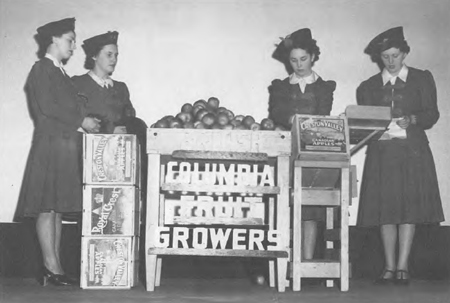 The four Apple Ambassadors were Aurelia and Alma Parent, sisters from Penticton, Doroth) Greenwood of Vernon, and Isobel Stillingfleet of Kelowna. Stillingfleet held the title of champion apple packer of the British Empire, which she had won at the 1937 Imperial Fruit Show in Birmingham, England. She was reported to work at the rate of an apple a second, "using a rhythmic swing that seemed humanly impossible to maintain for more than a few minutes." Three "clicks", so close together as to be nearly indistinguishable, followed by lightning-like placing in the box, constituted her style. The clicks were made when her left hand was placed on the pile of wrappers, when she "threw" an apple and the paper together, and when the paper was given a slight twist.' 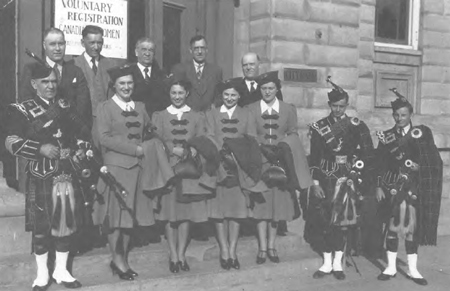 Despite wartime conditions, or perhaps because of them, the Ambassadors met with a cordial reception on their busy tour. In Medicine Hat, for example, they were greeted by a pipe band which escorted them to City Hall where Mayor Lang signed their Proclamation. Then it was on to demonstrations of packing at a Junior Board of Trade luncheon, four theatres, and nearly a dozen stores. Secretary Hayden reported that the girls "did their full share and more to promote better understanding and to make the Prairie people more apple conscious. The Second World War, which otherwise created so much stress, pain, and suffering, was a godsend to the cause of central selling. Under the provisions of the "War Measures Act" the federal government was invested with much wider powers than it held in peacetime, and could take jurisdiction even over matters that normally would be in the provincial sphere. Thus on September 7, 1940, a federal Order in Council gave the B.C. Fruit Board complete control over the marketing of apples, including the^power to pool and equalize returns to growers. Export sales then were placed under the control of B.C. Tree Fruits, to the United States in 1940 and to all export markets in 1941.
In 1942, a three-party contract among grower, shipper, and sales agency was devised so that when wartime controls were removed there would be no challenges to central selling. With the erratic wartime market making sale prices vary from day to day and market to market, "yardstick" pooling was gradually introduced. This ensured that growers would all receive the same return for a like size and grade of any particular variety of fruit. Efforts also continued to secure federal legislation which would give the agency peacetime compulsory control over the handling of the entire crop, rather than having to rely on voluntary agreements. This authority was not achieved, however, until 1949 with the passage of the federal "Agricultural Products Marketing Act", whose regulations supplemented the provincial Natural Products Marketing Act. These regulations allowed the B.C. Fruit Board full authority to regulate all marketing of tree fruit under its jurisdiction to all destinations. John Hall recalls lobbying for the measure: It was decided that A.K. Loyd and Jock Stirling and me would go to Ottawa. Jimmy Gardiner was Minister of Agriculture in those days, and he said, "I will go for this, but I know the Conservatives are against it, and I'm not sure of the Social Credit members and the CCF. If you can persuade them, fine." We had no trouble with the CCF. The Social Credit were a bunch of fools and we got really nowhere with them. And then we met the Conservatives in a caucus and there was a chap from Winnipeg [John Bracken], leader of the Conservatives in those days. They were pretty stuffy. . . . It got to a stage where A.K. turned to me and he said, "Mr. Hall" fairly formally, "there's no use staying around here any longer", and then, as a side remark that echoed around say the Conservatives are not interested in the farmers of Canada?" Well, gosh, that stopped him [Bracken] right off the bat. He called us back in again with the results that we went back to Jimmy Gardiner and told him the thing would go through."
The war years kept the sales agency on the jump. Export sales became erratic as embargoes, currency restrictions, and the lack of shipping for non-essential cargoes meant that traditional markets could not be relied upon. Shipments to Britain, for example, were 657 boxes in 1940, 1,200,000 in 1941, and none in 1942. The agency was continually on the lookout for other, nontraditional, export markets-one year 250,000 boxes were sold to Brazil. In 1943 the Wartime Prices and Trade Board was established, with E.J. Chambers going to Ottawa as Chairman of the Fresh Fruit and Vegetable Division of the Board. The Board established price ceilings, but it also restricted fruit imports. In a protected Canadian market, with little competition from imports, sales of B.C apples in eastern Canada increased dramatically, offsetting the loss of export markets. There was also a certain degree of federal subsidy during the war and early post-war years, averaging about one and a quarter cents a bushel between 1939 and 1949. The war years brought prosperity to B.C. fruit growers. The average return to growers per bushel of apples, including culls, rose from $.83 in the 1939 crop-year to $1.78 in the 1945 crop year." Art Garrish recalls the change he saw when he came back to the Okanagan after the War: I left a Valley here of tar-paper shacks and Bennett Buggies. I came back to a place that I couldn't even recognize. Finished houses with stucco outside. The Bennett Buggies had disappeared and the growers were even buying the odd secondhand car for their wife and kids, where before they had been lucky if they had one vehicle that would get into town. Now they had two and even three and they were buying tractors and sprayers. And of course there was no point in not doing so, because all the excess profit taxes were still in effect and would take the money from you if you weren't smart enough to spend it before the government got at it. Contact Us Hours: 9am - 4pm weekdays. t: 250-762-5226 |


